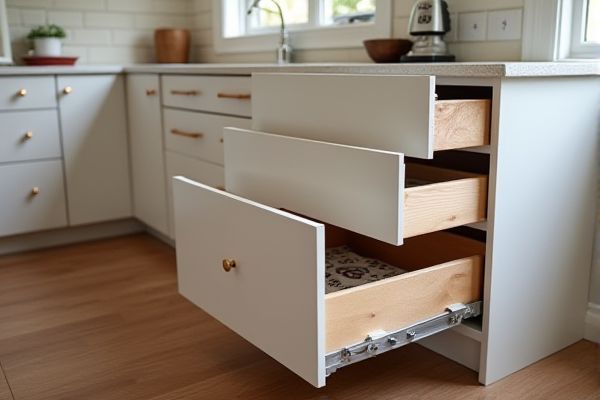
Stacked drawer systems maximize vertical storage space, making them ideal for compact areas, while side-by-side drawer systems offer wider accessibility and better organization for bulkier items. Discover which drawer system best suits Your storage needs by exploring the detailed comparison ahead.
Table of Comparison
| Feature | Stacked Drawer System | Side-by-Side Drawer System |
|---|---|---|
| Design | Vertical arrangement, one drawer above another | Horizontal arrangement, drawers placed next to each other |
| Space Efficiency | Maximizes vertical space, ideal for narrow areas | Maximizes horizontal space, suitable for wider layouts |
| Accessibility | Easy access to upper drawers, lower drawers may require bending | All drawers accessible at similar height, better ergonomics |
| Installation | Requires vertical clearance, simpler structural support | Needs wider cabinet space, may require stronger lateral support |
| Use Case | Ideal for kitchens, offices with limited width | Suitable for office desks, dressers, and wide cabinets |
| Cost | Generally lower due to simpler construction | Typically higher due to larger structural requirements |
Introduction to Drawer System Configurations
Stacked drawer systems consist of vertically aligned drawers that maximize vertical storage space, ideal for narrow or compact areas. Side-by-side drawer systems place drawers horizontally next to each other, allowing wider surface access and easier item visibility. Choosing between these configurations depends on space constraints, organizational needs, and ease of access.
What is a Stacked Drawer System?
A stacked drawer system consists of drawers placed directly above one another within a single cabinet frame, maximizing vertical space and providing efficient storage in compact areas. This design allows for easier access to multiple compartments without requiring additional floor space, ideal for organizing tools, office supplies, or kitchen utensils. Your choice of a stacked drawer system enhances storage density while maintaining a streamlined and accessible layout compared to side-by-side drawer systems.
Understanding Side-by-Side Drawer Systems
Side-by-side drawer systems feature drawers positioned next to each other horizontally, offering easy access to multiple compartments without overlapping. This layout optimizes storage efficiency by allowing users to organize items by category within a single row, reducing retrieval time. Your workspace benefits from improved visibility and quicker access compared to stacked drawer systems.
Space Efficiency Comparison
Stacked drawer systems maximize vertical space by allowing multiple drawers to be placed directly above one another, ideal for narrow or tall storage areas. Side-by-side drawer systems optimize horizontal space, providing wider drawer access but requiring more wall or surface width. For compact rooms, stacked systems offer better space efficiency, whereas side-by-side systems excel in wider layouts with easy lateral access.
Accessibility and Ergonomics
Stacked drawer systems enhance accessibility by allowing users to reach multiple drawers vertically without bending, promoting better posture and reducing strain. Side-by-side drawer systems offer ergonomic benefits by enabling easy horizontal access, minimizing reaching across wide spaces and accommodating natural arm movements. Both designs support efficient organization, but stacked systems optimize vertical space use while side-by-side layouts prioritize lateral reach comfort.
Storage Capacity and Organization
Stacked drawer systems maximize vertical storage capacity by allowing multiple drawers in a compact footprint, ideal for organizing smaller items efficiently within limited space. Side-by-side drawer systems offer broader surface area access, helping you spread out and categorize items horizontally, which enhances visibility and quicker retrieval. Choosing the right system depends on your spatial constraints and whether you prioritize vertical stacking for high capacity or horizontal layout for ease of organization.
Aesthetic Considerations
Stacked drawer systems offer a sleek, vertical alignment that enhances minimalistic and modern aesthetics by creating a clean, uninterrupted facade. Side-by-side drawer systems provide a balanced, symmetrical look that complements traditional or transitional interior styles, allowing for varied front finishes and handles to add visual interest. Your choice impacts the overall design harmony and can emphasize either verticality or width in the cabinetry layout.
Installation and Maintenance Factors
Stacked drawer systems typically require less floor space but may demand more precise vertical alignment during installation to ensure smooth operation, whereas side-by-side drawer systems offer easier access and simpler alignment but need more horizontal space. Maintenance for stacked drawers can be more complex due to the potential for weight distribution issues, while side-by-side drawers often allow straightforward repairs and easier replacement of individual components. Consider your available space and how maintenance accessibility impacts your long-term convenience when choosing the best system for your needs.
Cost Analysis of Both Systems
Stacked drawer systems generally offer a lower initial cost due to simpler installation and reduced material requirements, making them ideal for budget-conscious projects. Side-by-side drawer systems typically incur higher expenses because of increased hardware and space customization, but they provide better accessibility and organization. Your choice depends on balancing upfront costs with long-term functionality and space utilization needs.
Choosing the Best Drawer System for Your Needs
The stacked drawer system maximizes vertical storage by utilizing height, ideal for compact spaces or organizing smaller items, while the side-by-side drawer system offers wider access and better visibility, suitable for larger or frequently accessed items. Selecting the best drawer system depends on your space constraints and storage priorities, with stacked systems enhancing vertical efficiency and side-by-side systems improving horizontal reach and accessibility. Consider the type of items stored and user convenience to achieve optimal functionality in your storage solution.
 homyna.com
homyna.com